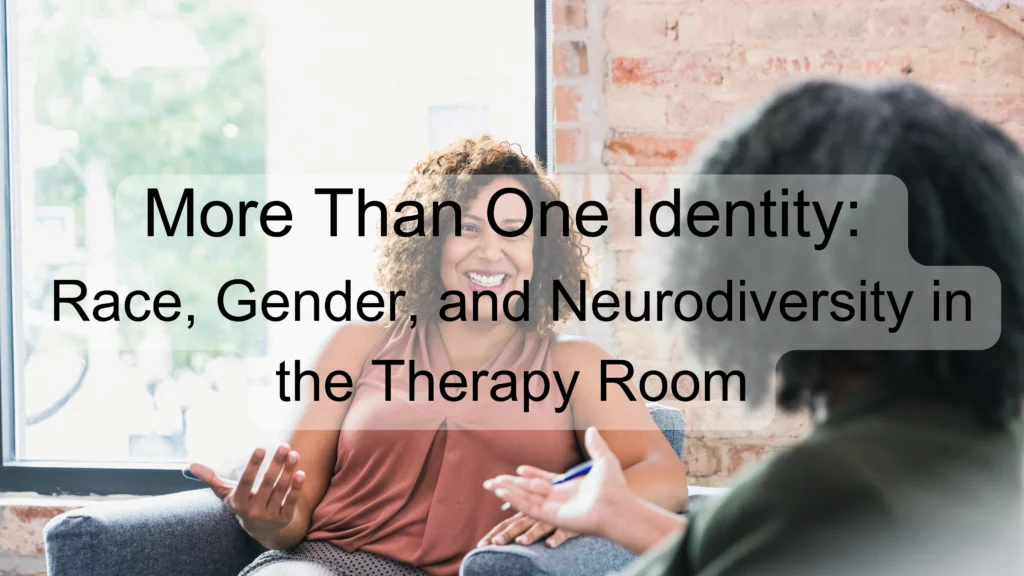More Than One Identity: Race, Gender, and Neurodiversity in the Therapy Room
In clinical training, we are taught to explore identity with nuance—race, gender, sexuality, class, and culture. Yet when it comes to neurodivergence, these discussions are too often siloed or treated as separate from other parts of the client’s experience.
But neurodivergent clients don’t experience their brain differences in isolation. They experience them as Black or Indigenous, as trans or queer, as immigrants, as people shaped by systems of oppression.
This post explores what it means to practice psychotherapy that acknowledges the intersections between neurodiversity, race, gender, and social context. We also explore how therapists can avoid replicating harm in the consulting room.
Neurodivergence Does Not Exist in a Vacuum
Intersectionality—a term coined by Kimberlé Crenshaw—refers to how multiple forms of identity (and oppression) interact. Neurodivergent clients may also belong to marginalised racial, ethnic, cultural, and gender communities, leading to:
- Compounded stigma and misdiagnosis
- Cultural invisibility (e.g. “autism is a white boy’s condition”)
- Barriers to diagnosis, access, and support
- Misunderstood communication styles and expressions of distress
“No one thought I could have ADHD—I was a Black girl who got straight A’s. I just learned to disappear.” – Late-diagnosed client
The Double (or Triple) Mask
For many neurodivergent clients who are also BIPOC, queer, or gender-diverse, masking takes on an additional layer of survival:
- Suppressing neurodivergent traits to avoid racial or gender-based stereotyping
- Overperforming in professionalism or politeness to “counter” bias
- Navigating cultural expectations that stigmatise both mental health and neurodivergence
- Modifying identity presentation to remain “safe” in healthcare settings
This double-masking increases burnout, emotional suppression, and dissociation, often presenting in therapy as anxiety, exhaustion, or emotional flatness.
Therapist Note: When clients appear disengaged or overly composed, ask what effort it takes to appear that way. You may be witnessing survival, not disinterest.
Misdiagnosis and Diagnostic Gaps
Many assessments for ADHD, autism, and learning differences were developed using white, male, Western-centric samples. As a result:
- BIPOC children are underdiagnosed with autism but overdiagnosed with conduct disorders
- Women and nonbinary people are often missed, due to differences in presentation
- Cultural behaviours may be misunderstood as pathology, or vice versa
Therapists must question their diagnostic instincts and be mindful of the systemic biases embedded in psychological tools.
Supporting Clients at Intersections
Therapists who aim to be genuinely inclusive must address neurodivergence as a lived experience shaped by all identities, not just a clinical label.
Ask questions like:
- How does your background influence how you think about mental health or neurodivergence?
- Have you ever felt you had to hide parts of yourself in different communities?
- What was your experience with school, family, or healthcare systems?
- Who gets to be seen as “different,” and who gets punished for it?
Therapy becomes not just a place to unpack identity, but to imagine new ways of being whole.
Therapist Strategies for Inclusive Neurodivergent Care
| Focus Area | Clinical Practice |
| Language | Use identity-first or person-first language as per client’s preference. Avoid pathologizing difference. |
| Pace & Style | Respect processing time and alternative communication styles. Some clients may prefer silence, stimming, or minimal eye contact. |
| Cultural Curiosity | Don’t assume shared meanings. Ask how cultural or spiritual beliefs influence the client’s understanding of their neurodivergence. |
| Affirmation | Name the impact of racism, transphobia, or xenophobia on how neurodivergence is seen or responded to. |
| Empowerment | Frame the client’s survival strategies as strengths—not dysfunctions. Collaborate in exploring unmasking or boundary-setting. |
Therapist Reflection Prompt
Whose stories have shaped my understanding of ADHD, autism, and learning differences? Who is missing? How might I widen the lens of who I believe can be neurodivergent?
Final Thoughts
Clients are never “just neurodivergent,” “just Black,” “just trans,” or “just disabled.” They live at complex intersections that shape how they’re seen—and how they see themselves. Honouring the fullness of identity is not just ethical—it’s essential.
When clients tell you who they are, believe them, especially when they show you more than one thing.
Coming Next:
“From Deficit to Difference: De-pathologising Neurodivergent Clients in Clinical Practice”
For more insightful blogs, visit my main blog page here
Download your FREE Professional Cheat Sheet here

